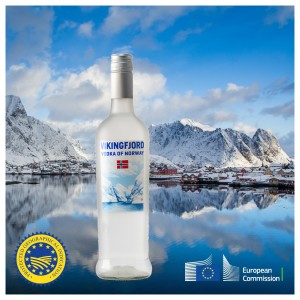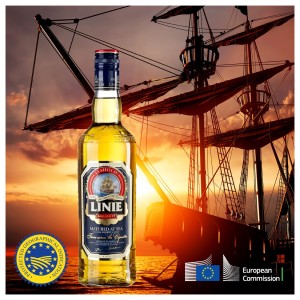It is a good day to celebrate in Norway—the European Union has granted approval for two new Protected Geographical Indications (PGIs) for the distinctive spirit drinks of Norway: Norsk Vodka (Norwegian Vodka) and Norsk Akvavit (Norwegian Aquavit).
Norsk Vodka is defined as a “clear, transparent and colorless” spirit, bottled at a minimum of 37.5% abv (products up to 60% abv are also allowed). It must be produced using potatoes or grains as its base ingredient, and it must be mashed, fermented, and distilled within the borders of the Kingdom of Norway. It is, however, allowed to be diluted (with water) and bottled outside of the country.
One interesting part of the EU standard is that Norsk Vodka must be fermented using cultivated yeast as opposed to spontaneous fermentation. The use of cultivated yeast produces a base ferment that is low in congeners. Another part of the regulation states that the spirit must be distilled to a minimum of 96% abv (192°). According to the technical file, these factors combine to create a clean, fresh-tasting finished product free of the “burning aftertaste” that sometimes accompanies a shot of vodka.
With the approval of Norsk Vodka, there are now six countries with PGI status for their distinctive vodka: Norway, Poland, Sweden, Finland, Lithuania, and Estonia.
A PGI for Norsk Akvavit (which may also be referred to as Norsk Akevitt, Norsk Aquavit, or Norwegian Aquavit) was also approved this week. Norsk Akvavit may be bottled at a variety of strengths, ranging from 37.5% to 60% alcohol by volume. Potatoes are the only allowed base ingredient, and a minimum of 95% of the potatoes must be of Norwegian origin.
The main flavorings must be derived from caraway or dill, and the product should contain specific amounts of the flavor-rich substances limonene (reminiscent of citrus) and carvone (found in caraway, dill, and spearmint). Other botanicals may be used to flavor Norsk Akvavit, including (but not limited to) aniseed, celery seed, chamomile, coriander seed, fennel seed, grains of paradise, dried lemon peel, dried bitter orange peel, and star anise.
After flavoring, the Norsk Akvavit must spend a minimum of 6 months in oak casks (provided the casks are smaller than 1,000 liters in volume), or 12 months minimum in larger casks. It is traditional to age the akvavit in barrels that previously held fermented beverages such as Sherry, Madeira, and Port wine; however, new barrels are also allowed. As a result, Norsk Akvavit may be bottled in a range of colors from water-white to dark amber.
Raise a glass to Norway!
References/for more information:
- Official Journal of the European Union – Norwegian Vodka PGI
- Official Journal of the European Union – Norwegain Aquait PGI
Post authored by Jane A. Nickles…your blog administrator: jnickles@societyofwineeducators.org

